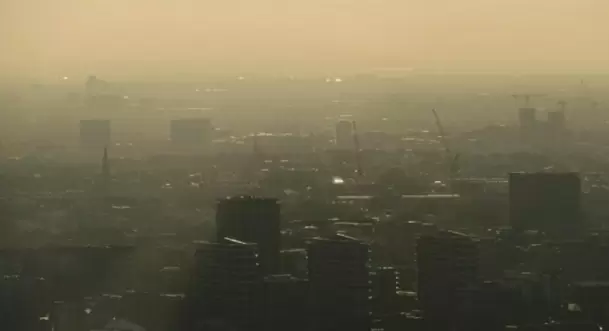No progress despite National Clean Air Programme: Air Programme
10-January-2022

Three years since the National Clean Air Programme (NCAP) was implemented across India to reduce particulate matter levels in 132 cities by 20-30 per cent, data on Monday showed there has been little or no progress on ground.
An analysis of the government's air quality data showed that not only have most non-attainment cities reduced PM 2.5 and PM 10 levels marginally, some have also recorded an increase.
The Union government launched the NCAP on January 10, 2019 to address air pollution in 102 cities, to which 20 more cities were added later in the year and 10 more subsequently.
These 132 cities are called non-attainment cities as they did not meet the national ambient air quality standards (NAAQS) for the period of 2011-15 under the National Air Quality Monitoring Program (NAMP).
The country's current annual safe limits for PM 2.5 and PM 10 are 40 and 60 micrograms/per cubic metre (ug/m3).
The NCAP has set a target of reducing key air pollutants PM10 and PM2.5 (ultra-fine particulate matter) by 20-30 per cent in 2024 taking the pollution levels in 2017 as the base year to improve upon.
The Ministry of Environment, Forests and Climate Change and Central Pollution Control Board are leading the programme at the national level. At the state level, state pollution control boards are mandated to develop the city action plans and monitor their implementation by identified departments and agencies.
An analysis of air quality monitoring data from the Continuous Ambient Air Quality Monitoring System (CAAQMS) shows that among the cities where PM 2.5 and PM 10 levels for 2019 and 2021 were available and monitors had an uptime of at least 50 per cent, Varanasi in Uttar Pradesh recorded the highest reduction.
Only 36 out of the 132 cities met the criteria.
Varanasi's annual PM 2.5 levels reduced 52 per cent from 91 ug/m3 in 2019 to 44 ug/m3 in 2021 and its PM 10 levels reduced 54 per cent from 202 ug/m3 in 2019 to 93 ug/m3 last year.
In 2019, Varanasi had just one CAAQMS monitor which increased to four by 2021. The other cities that have already met its reduction target of at least 20 per cent were Hubli in West Bengal where PM 2.5 and PM 10 reduced by 42 and 40 per cent respectively and Talcher in Odisha which saw a PM 2.5 reduction of 20 per cent and PM 10 reduction of 53 per cent.
Ahmedabad recorded a 26 per cent decrease in PM 10 levels. On the other hand, Navi Mumbai's PM 2.5 levels increased from 39 ug/m3 to 53 ug/m3 and PM 10 levels increased from 96 ug/m3 to 122 ug/m3 from 2019 to 2021.
Three years later, none of the analysed non-attainment cities have met the Central Pollution Control Board's PM 10 safe standard of 60 ug/m3.
The NCAP Tracker ranked the 10 most and least polluted cities in 2019 and tracked the performance of these based on PM 10 and PM 2.5 data available from CAAQMS.
Considering only those cities where monitors recorded a minimum uptime of 50 per cent, a total of 38, 46 and 58 cities were analysed and ranked in 2019, 2020 and 2021 respectively.
Similarly, the tracker also ranked non-attainment cities (which recorded at least 52 days of data each year) based on NAMP data for the years 2017 to 2020. However, the number of monitored days for 2020 was not available and hence all cities have been considered.
While in the same city, CAAQMS and NAMP monitors are placed at different locations and hence, cities have been ranked separately.
Ghaziabad in Uttar Pradesh with annual PM 2.5 levels above 100 remained at the top of the table in the most polluted cities except 2020 when Lucknow ranked first with an annual PM 2.5 level of 116.
Most other cities like Noida, Delhi, Moradabad and Jodhpur saw only a marginal dip in PM 2.5 levels and remained in the top 10 polluted non-attainment cities throughout the year.
Varanasi with its drastic dip in PM 2.5 levels went from the fifth rank in 2019 to the 37th in 2021. While four of the top 10 polluted cities were from Uttar Pradesh, West Bengal had three cities -- Howrah, Asansol and Kolkata -on the list.-IANS
Rajinikanth Turns 75: Anil Kapoor, Kajol Lead Heartfelt Birthday Tributes
Conspiracy Underway To Remove Nitish Kumar, Claims Mukesh Sahani
‘Something Wrong’: SC Questions Madras HC’s Handling of Karur Stampede Case
Sir In Bengal: Eci Identifies 58 Lakh Excludable Voters After Enumeration Phase Ends
Shivakumar Defends Hate Speech Bill, Accuses BJP Of Spreading Division, Hatred Among People









